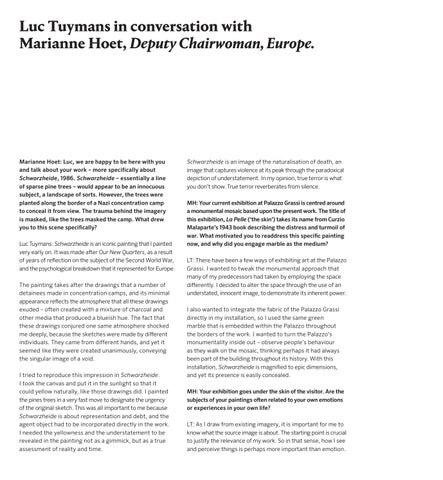Luc Tuymans in conversation with Marianne Hoet, Deputy Chairwoman, Europe.
Marianne Hoet: Luc, we are happy to be here with you and talk about your work – more specifically about Schwarzheide, 1986. Schwarzheide – essentially a line of sparse pine trees – would appear to be an innocuous subject, a landscape of sorts. However, the trees were planted along the border of a Nazi concentration camp to conceal it from view. The trauma behind the imagery is masked, like the trees masked the camp. What drew you to this scene specifcally? Luc Tuymans: Schwarzheide is an iconic painting that I painted very early on. It was made afer Our New Quarters, as a result of years of refection on the subject of the Second World War, and the psychological breakdown that it represented for Europe. The painting takes after the drawings that a number of detainees made in concentration camps, and its minimal appearance refects the atmosphere that all these drawings exuded – often created with a mixture of charcoal and other media that produced a blueish hue. The fact that these drawings conjured one same atmosphere shocked me deeply, because the sketches were made by diferent individuals. They came from different hands, and yet it seemed like they were created unanimously, conveying the singular image of a void. I tried to reproduce this impression in Schwarzheide. I took the canvas and put it in the sunlight so that it could yellow naturally, like those drawings did. I painted the pines trees in a very fast move to designate the urgency of the original sketch. This was all important to me because Schwarzheide is about representation and debt, and the agent object had to be incorporated directly in the work. I needed the yellowness and the understatement to be revealed in the painting not as a gimmick, but as a true assessment of reality and time.
Schwarzheide is an image of the naturalisation of death, an image that captures violence at its peak through the paradoxical depiction of understatement. In my opinion, true terror is what you don’t show. True terror reverberates from silence. MH: Your current exhibition at Palazzo Grassi is centred around a monumental mosaic based upon the present work. The title of this exhibition, La Pelle (‘the skin’) takes its name from Curzio Malaparte’s 1943 book describing the distress and turmoil of war. What motivated you to readdress this specifc painting now, and why did you engage marble as the medium? LT: There have been a few ways of exhibiting art at the Palazzo Grassi. I wanted to tweak the monumental approach that many of my predecessors had taken by employing the space diferently. I decided to alter the space through the use of an understated, innocent image, to demonstrate its inherent power. I also wanted to integrate the fabric of the Palazzo Grassi directly in my installation, so I used the same green marble that is embedded within the Palazzo throughout the borders of the work. I wanted to turn the Palazzo’s monumentality inside out – observe people’s behaviour as they walk on the mosaic, thinking perhaps it had always been part of the building throughout its history. With this installation, Schwarzheide is magnifed to epic dimensions, and yet its presence is easily concealed. MH: Your exhibition goes under the skin of the visitor. Are the subjects of your paintings ofen related to your own emotions or experiences in your own life? LT: As I draw from existing imagery, it is important for me to know what the source image is about. The starting point is crucial to justify the relevance of my work. So in that sense, how I see and perceive things is perhaps more important than emotion.
